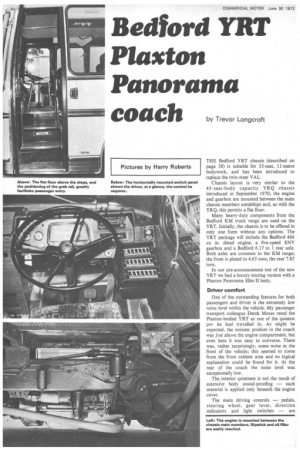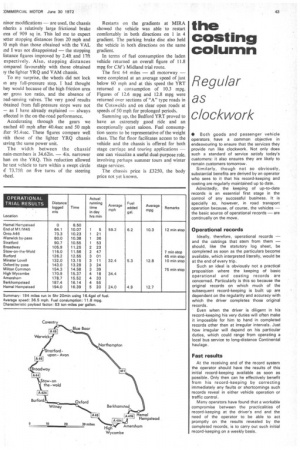Bedford YET Plaxton Panorama
Page 42

Page 44

Page 45

If you've noticed an error in this article please click here to report it so we can fix it.
coach by Trevor Longcroft
THE Bedford YRT chassis (described on page 38) is suitable for 53-seat, 11-metre bodywork, and has been introduced to replace the twin-steer VAL.
Chassis layout is very similar to the 45-seat-body capacity YRQ chassis introduced in September 1970; the engine and gearbox are mounted between the main chassis members amidships and, as with the YRQ, this permits a flat floor.
Many heavy-duty components from the Bedford KM truck range are used on the YRT. Initially, the chassis is to be offered in only one form without any options. The YRT package will include the Bedford 466 cu in. diesel engine, a five-speed ENV gearbox and a Bedford 6.17 to 1 rear axle. Both axles are common to the KM range; the front is plated to 4.65 tons, the rear 7.85 tons.
In our pre-announcement test of the new YRT we had a luxury touring version with a Plaxton Panorama Elite II body.
Driver comfort
One of the outstanding features for both passengers and driver is the extremely low noise level within the vehicle. My passenger transport colleague Derek Moses rated the Plaxton-bodied YRT as one of the quietest psv he had travelled in. As might be expected, the noisiest position in the coach was just above the engine compartment, but even here it was easy to converse. There was, rather surprisingly, some noise at the front of the vehicle; this seemed to come from the front cabinet area and no logical explanation could be found for it. At the rear of the coach the noise level was exceptionally low.
The interior quietness is not the result of extensive body sound-proofing — such material is applied only beneath the engine cover.
The main driving controls — pedals, steering wheel, gear lever, direction indicators and light switches — are positioned comfortably for the driver. The parking brake is conveniently placed to the right side of the seat, the gear lever equally well placed to the left.
A horizontal switch panel on the off-side, just below knee height, covering most of the saloon fittings and auxiliaries, is an improvement on typical vertical panels; one can identify switches at a glance and a driver unfamiliar with the vehicle has no need to fumble.
Clutch pedal pressure for the air /hydraulic system was light, as was brake pedal pressure. Unfortunately, brake pedal "feel" left something to be desired: the response to pedal pressure seemed inconsistent so that one sometimes needed an unexpected amount of pedal travel.
All-round visibility is good and the screen pillars do not obstruct one's view of the mirrors. The wipers clear a useful arc.
Ride and handling The midships engine and transmission position allows good weight distribution throughout the chassis length. From the driver's seat, little if any bounce or pitch was noticed and roll could be provoked only when cornering deliberately at higher than normal operational speeds.
The best standard of ride is obviously obtained when sitting within the wheelbase. Although Derek Moses did not, as a passenger, find any evidence of pitch or bounce, he thought the ride over the rear axle a little hard. Steering effort, despite the Hydrosteer ram power assistance is excessive, although the effort required decreases as the steering tends towards full lock. On the motorway the vehicle pulled slightly to the nearside and some correction was necessary to keep it straight.
The gearchange proved difficult. Changing improved slightly with continuous use, but nevertheless a really smooth change was not achieved throughout the trial. Deliberate, purposeful movements of the lever were required to effect a change. Seeking smoother changes, I tried two other methods — a slower change, pausing while passing through the gate, and doubledeclutching. The latter did meet with some success but neither method made for particularly smooth change.
Unlike the YRQ, the YRT has an ENV five-speed gearbox with synchromesh on the higher four ratios; fifth is an overdrive gear. The gears are well spaced, apart from too wide a gap between third and fourth. When changing up at maximum revs in third gear, one meets a short flat-spot before the engine pulls away.
The YRT has the same axles as the KM and because KM brakes — except for some ninor modifications are used, the chassis nherits a relatively large frictional brake trea of 909 sq in. This led me to expect )etter stopping distances from 20 mph and 10 mph than those obtained with the VAL ind I was not disappointed the stopping listance figures improved by 2.4ft and 17ft espectively. Also, stopping distances iompared favourably with those obtained )y the lighter YRQ and VAM chassis.
To my surprise, the wheels did not lock m any full-pressure stop. I had thought hey would because of the high friction area ter gross ton ratio, and the absence of oad-sensing valves. The very good' results ibtained from full-pressure stops were not as I have already explained always effected in the on-the-road performance.
Accelerating through the gears we eached 40 mph after 40.4sec and 50 mph ifter 95.4sec. These figures compare well vith those of the lighter YRQ chassis laving the same power unit.
The width between the chassis' nain-members is 34.62in. 4in. narrower han on the YRQ. This reduction allowed he test vehicle to turn within a swept circle if 73.75ft on five turns of the steering yheel. Restarts on the gradients at MIRA showed the vehicle was able • to restart comfortably in both directions on 1 in 4 gradient. The parking brake disc also held the vehicle in both directions on the same gradient.
In terms of fuel consumption the laden vehicle returned an overall figure of 11.8 mpg for GM's Midland trial route.
The first 64 miles all motorway were completed at an .average speed of just below 60 mph and at this speed the YRT returned a consumption of 10.3 mpg. Figures of 12.6 mpg and 12.8 mpg were returned over sections of "A" type roads in the Cotswolds and on clear open roads at speeds of 50 mph for prolonged periods.
Summing up, the Bedford YRT proved to have an extremely good ride and an exceptionally quiet saloon. Fuel consumption seems to be representative of the weight class. The flat floor facilitates access to the vehicle and the chassis is offered for both stage carriage and touring applications one can visualize a useful dual-purpose role. involving perhaps summer tours and winter stage services.
The chassis price is £3250, the body price not yet known.




























































































